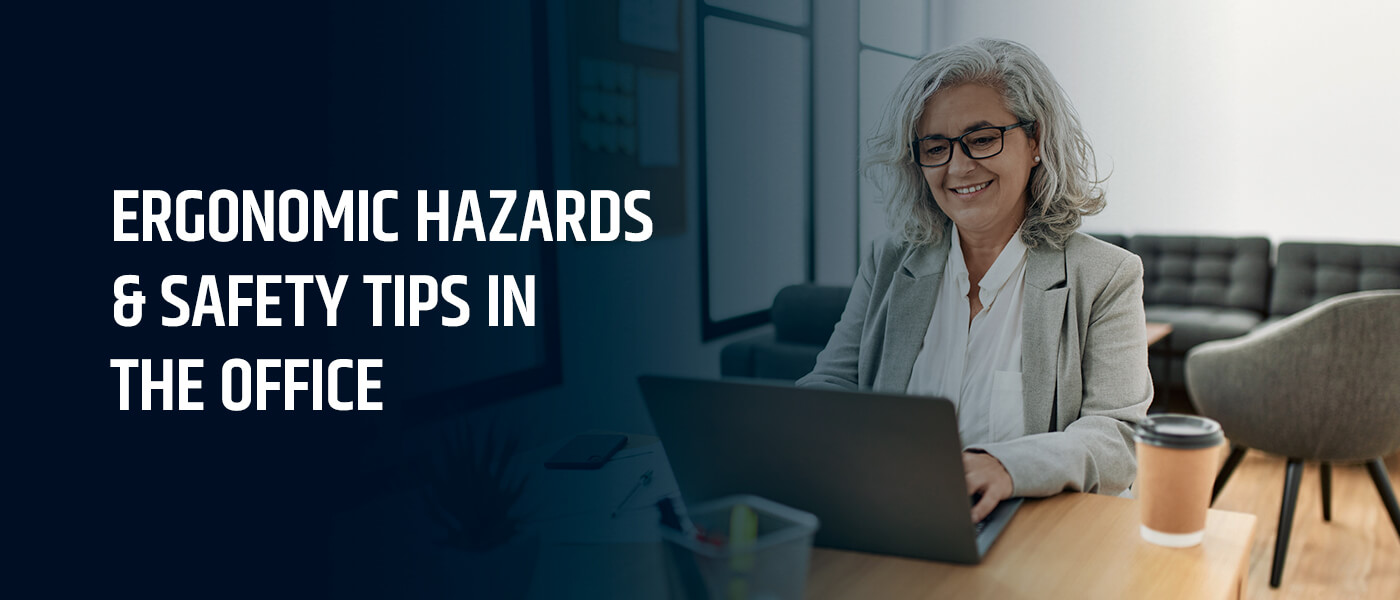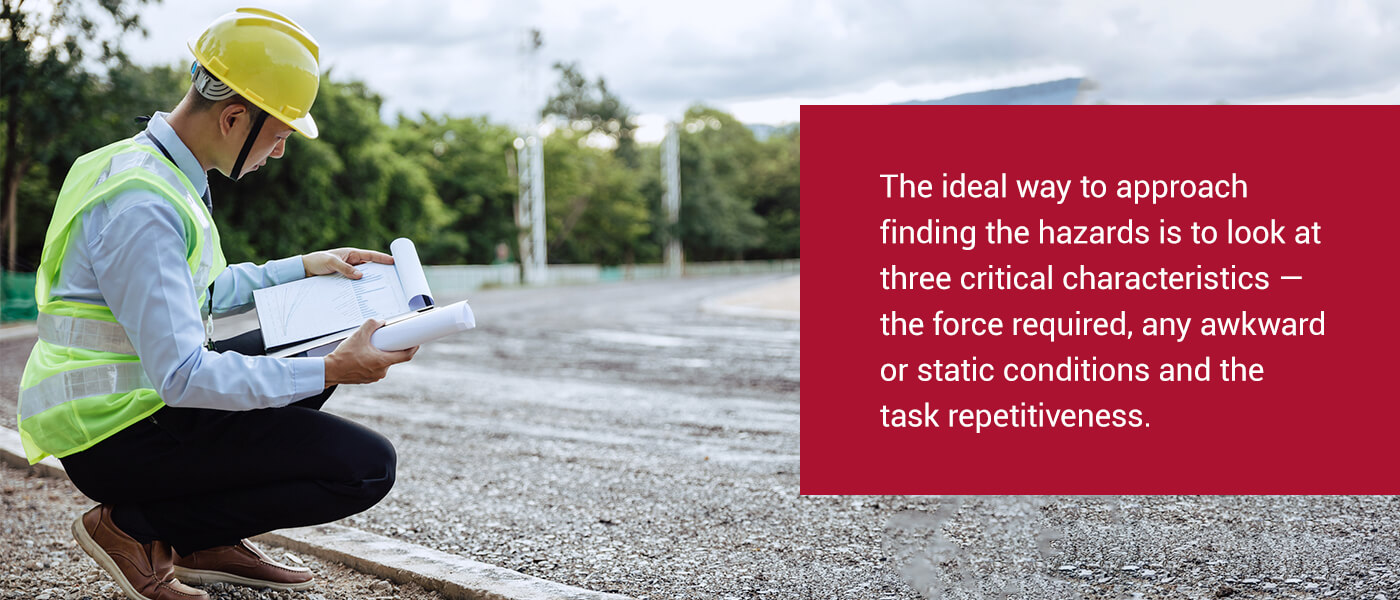
Workplace injuries are regular occurrences throughout various industries. Whether lifting heavy items, bending over, pushing and pulling or even sitting and standing for extended periods can lead to musculoskeletal disorders (MSDs). These disorders impact areas of the body such as the muscles, nerves, blood vessels and more. Since MSDs are often associated with high costs for the employer, companies should look for ways to minimize these risks and improve their environment.
Ergonomics studies people in their working environment, focusing on how to fit the work around the worker, not the other way around. Employers are responsible for providing safe conditions for their employees to operate. Learning to improve your ergonomics at the office could lead to substantial benefits in terms of health and costs. Learn how to identify ergonomic hazards and get some beneficial safety tips to improve your workplace ergonomics.

Common Ergonomic Hazards at the Office
Workers in industries like construction, food processing, office jobs and warehousing are at risk of developing MSDs from overexertion and exposure to certain risk factors. Regardless of the setting, it is the employer’s job to create an environment designed to protect its employers. This protection often comes from forming a strategic ergonomic process consisting of essential elements to involve workers, provide training, offer the support they need and evaluate the effectiveness of implemented solutions.
For any plan to be successful, employers and safety officials much take time to identify the ergonomic hazards in the workplace. Doing this lets professionals pinpoint potential risks to their employees before they result in MSDs. The ideal way to approach finding these hazards is to look at three critical characteristics — the force required, any awkward or static conditions and the task repetitiveness. Review injury and illness records, analyze work conditions and processes, interview your workers and review surveys.
Throughout your search, keep an eye out for some of the following ergonomic hazards:
- Frequent lifting
- Working in awkward postures
- Remaining in the same posture for extended periods
- Extreme hot or cold temperatures
- Vibration
- Exerting excessive effort or force
- Conditions involving direct pressure
- Poor lighting
- Storing shared equipment or supplies in out-of-reach areas
Ergonomic Safety Tips for the Office
If you’re unsure how to avoid ergonomic hazards and improve overall performance, plenty of administrative and engineering controls are worth implementing. Engineering controls are physical changes you can make to enhance ergonomic safety while reducing exposure to risk, such as portable air conditioning to prevent overheating. Administrative controls are changes in procedures, processes, schedules and training to minimize targeted hazards.
Take a look at the following ergonomic safety tips to enhance your office or facility’s performance and safety:
- Keep areas organized and clean: Organization drastically improves efficiency and comfort in the workplace. Employees will understand where everything is, decreasing stress and reducing the chances of making mistakes. It is also wise to keep materials and equipment accessible at waist height to reduce stretching and reduce the risk of tripping.
- Allow time for recovery: Recovery is an essential aspect of any workplace environment. Provide employees with regular breaks scheduled throughout the day and optimize schedules to minimize overtime. Consider increasing your staff numbers to decrease the stress and workload placed on each individual. Recovery time, whether vacation, sick days or just breaks throughout the day, benefits workers through higher productivity, increased job satisfaction and creativity, improved mental health and a greater sense of well-being.
- Encourage early reporting of injuries: Create an open line of communication between employees and management regarding workplace injuries, including a standard process to follow for reporting injuries as soon as they happen. This will help your employees receive the proper diagnosis and treatment, decreasing the severity and giving them a better chance to recover fully. Early reporting also gives your team time to assess areas of your workplace where improvements should be made, ensuring you do your part to mitigate the chances of further injury.
- Mix it up: Overexertion and repetitive stress are the second leading cause of workplace injuries. By rotating workers, you let them participate in different tasks and activities, reducing the time spent repeating any one motion.
- Train staff for proper techniques: For certain facilities, lifting is a common practice that threatens workers’ safety. It’s essential to train them on lifting slowly and carefully, keeping their back straight, lifting with their legs and using shoulder pads to cushion loads. You may also find it helpful to assign two or more team members when carrying loads over certain weights.
- Use adjustable equipment: Whether sitting at desks working on computers or in a warehouse using heavy machinery, adjustable equipment is necessary to meet workers’ needs. Each employee is of varying height and weight with different strengths and weaknesses. Adjustable equipment such as desks, chairs or machinery can reduce strain on workers’ bodies and improve overall posture.
How to Improve Employee Ergonomics at the Office
When employees begin developing issues like back pain, arthritis, shoulder injuries or carpal tunnel, it’s essential to take steps to prevent future problems and preserve the health of your workers. You can protect your employees from an assortment of injuries and accidents with the help of some straightforward ergonomic strategies. These strategies will also help increase overall efficiency, decrease workers’ compensation costs due to MSDs and support your company’s overall bottom line.
Improving the ergonomics in your workplace is a fairly straightforward process you can achieve by focusing on vital body movements like:
- Maintaining good posture
- Keeping joints in a neutral position
- Avoid forward bending
- Minimize twisting and reaching movements
- Keeping all work close to the body
- Reducing time spent in one position
Consider encouraging employees to implement a pre-work and post-work stretch to mitigate the effects of a long day at the desk or behind the wheel of a machine.
Purchase NASP’s Workplace Ergonomics Specialist Course
The National Association of Safety Professionals (NASP) is ready to give you what you need if you’re looking for ways to improve your ergonomics at the workplace. We work with different industries, from construction and government agencies to oil and gas organizations. Our experts work hard to provide an array of professional certificates and safety and environment consulting services with classroom, on-site and online training to enhance workplace safety and productivity.
At NASP, we can help you take your worker support to the next level through our comprehensive Workplace Ergonomics Specialist (WES) course. Companies of every size will benefit from our approach, learning how to identify different types of MSDs, risk factors and the best ergonomics practices for various environments. Purchase the course to get started, or contact NASP to learn more today.






